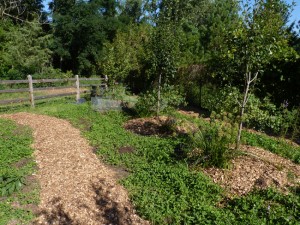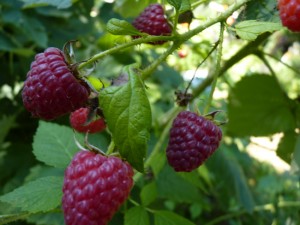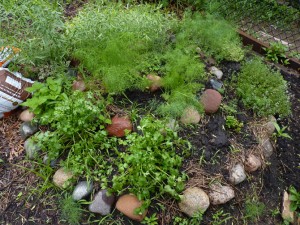Lughnasa Waxing Honey Extraction Moon
Walked in the garden alone. Yep, it’s an old time spiritual, much loved in the churches of my youth. It also describes my morning turn among our vegetables and in our orchard.
The garlic has come out already. The potatoes have a while yet to go. The beans have gone from green bean material to soup beans, waiting now for the pods to dry on the vine. A few onions remain, as for the tomatoes, there are a lot of possibilities, but as the weather cools, will they ripen? In the orchard we’ve had more productivity than any year so far, a few cherries, lots of currants, many dropped plums, but a few now maturing on the tree. The apples, in their plastic sandwich bags, have begun to swell on the honeycrisp tree, but on the other, a green apple, they’re not a lot bigger than when the bags went on in July. Our blueberries came and disappeared into the mouths of birds.
The wild grape harvest looks like it will be a big one this year. These vines are everywhere on our property, but the ones that produce the most fruit hang in dense layers over the northern fence that fronts our orchard. Picking the wild grapes usually marks the end of the gardening year here at Artemis Hives and Gardens, at least the food gardening.
The fall flowers of course begin to bloom then, the asters, the mums, the monkshod, the clematis. It’s also the time to plant bulbs, tulips and daffodils, lilies and croci. It is, too, the time that the garlic bulbs harvested in July, yield up cloves from the largest bulbs for planting. I like planting the garlic in late August, early September. Garlic is a counter culture crop, sown in the fall and harvested mid-summer.
Senescence has fascinated me for a long time. Earlier in my life the process of degradation that rotted wood, turned leaves into humus and prepared more soil got my attention. An early interest, I suppose, in the great chain of being (note the lower case here, less Scholastic, more Great Wheel). Now I’ve noticed another key aspect of senescence; it is the time of harvest. Yes, in the plant world, the dying of the plant’s above earth body follows or is in step with the giving of its fruit. That is, aging produces
This is also the time when gardening begins to wane in interest for me. My energies now turn to novels, research for tours at the MIA, preparing for the fall issue selection process at the Sierra Club and the upcoming legislative session.
Now, too, the cruise, which begins in October, looms closer and the loose ends for it need to be tidied. The Brazilian visa. New luggage. Check the clothes. Rent a tux. (yes. I’m gonna do it. 3 formal nights a week on the cruise. i’ll pretend it’s halloween every one of those nights. i’ll be some seriously weird expatriate Muscovite on the run from Putin’s secret police. something like that.)

 third garden tier.
third garden tier. further behind than I thought I’d be. The resistance work has taken a while to work its way into my exercise cycle, but it’s there now.
further behind than I thought I’d be. The resistance work has taken a while to work its way into my exercise cycle, but it’s there now. have begun to germinate and I plan to plant more bush beans tomorrow if the weather is ok.
have begun to germinate and I plan to plant more bush beans tomorrow if the weather is ok.